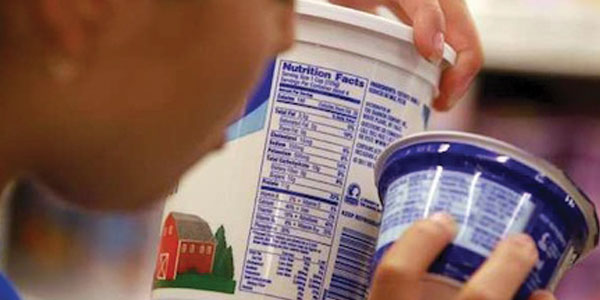
Cholesterol: Describes the amount of cholesterol that each portion has. Cholesterol is the one that builds the membranes of the cells of our body, especially the nervous system. The total amount of cholesterol that can be consumed in a day should not be above 300 mg. This is controversial because dietary cholesterol contains the production of cholesterol from the blood, which means that is healthy to consume. The opposite of what many people who do not have scientific training in nutrition think.
You can also find in Google the reports of Professor Enrique Melendez Hevia, where cholesterol consumed in the diet is the production of cholesterol that goes to the blood.
Trans fats: Also called “hydrogenated” or “partially hydrogenated” fats are on the list of ingredients. They are made artificially from saturated fats. Trans fats make food stay cooler longer on shelves and are used in many manufactured products that are not refrigerated. Trans fats are associated with heart disease, increase bad cholesterol (LDL) and lower good cholesterol (HDL).
All labels must say “0 grams” or “0 g” if it has trans fats DO NOT CONSUME.
Unsaturated fats: Monounsaturated fats and polyunsaturated fats (omega-6 and omega-3 fatty acids) can reduce bad cholesterol and increase good cholesterol these are the “good fats” and those that should consume up to 30% of calories as unsaturated fats, more than this percentage can increase our bad cholesterol (remember that eating nothing in excess is the key to a healthy diet).
These are the so called “essential” fats or essential fatty acids, can cause desease if you don’t eat them: this are the arachidonic acid, alpha linoleic acid (omega 3 fatty acid), linoleic acid (omega 6 fatty acid) and oleic acid. Generally, they are found in vegetable oils such as canola, olive, soy, corn, etc.; nuts, green vegetables, sunflower seeds, flax seeds, cardamom, sunflower, walnuts, avocado, fish, eggs, poultry, etc.
I recommend videos on youtube, for more information on concepts about saturated fats:
http://www.youtube.com/watch?v=4eVZmBMgff0 “Carbohydrates and saturated fats, research, development and new school of thought”
http://www.youtube.com/watch?v=vRe9z32NZHY “How to eat saturated fats: They are good for you” Donald W. Miller Jr., MD
______________________________________________________________________________________________
Consejos sobre cómo leer etiquetas de alimentos: Parte 3
Colesterol: describe la cantidad de colesterol que tiene cada porción. El colesterol es el que forma las membranas de las células de nuestro organismo especialmente el sistema nervioso. La cantidad total de colesterol que se recomienda consumir en un día no debe estar por encima de 300 mg, una vez más, esto es controversial porque el colesterol dietético bloquea la producción de colesterol de la sangre, o sea que es saludable consumir colesterol contrario a lo que mucha gente que no tiene formación científica en nutrición, piensa; ver arriba Grasas saturadas.
También se puede encontrar en Google los reportes del profesor Enrique Melendez Hevia donde habla de cómo el colesterol que consumimos en la dieta detiene la producción del colesterol que va a la sangre.
Grasas trans: También llamadas grasas “hidrogenadas” o “parcialmente hidrogenadas” en la lista de ingredientes. Están hechas artificialmente a partir de las grasas saturadas. Las grasas trans hacen que la comida se mantenga fresca más tiempo en los estantes y se utilizan en muchos alimentos manufacturados que no están refrigerados. Las grasas trans se asocian con enfermedades del corazón, aumentan el colesterol malo (LDL) y disminuyen el colesterol bueno (HDL).
Toda etiqueta debe decir «0 gramos» o «0 g» si tiene grasas trans NO LA CONSUMA.
Las grasas no saturadas: grasas monoinsaturadas y grasas poliinsaturadas (omega-6 y omega-3 los ácidos grasos) pueden reducir el colesterol malo y aumentar el colesterol bueno estas son las “grasas buenas” y que deben consumir hasta un 30% de las calorías como grasas insaturadas, más de este porcentaje puede aumentar nuestro colesterol malo (recuerde que nada en exceso es la clave para una dieta saludable!).
Estas son las llamadas grasas “esenciales” o ácidos grasos esenciales los cuales si no se consumen causan enfermedades: estos son el ácido araquidónico, ácido alpha- linoleico (omega 3 fatty acid) ácido linoleico (omega 6 fatty acid) y ácido oleico. En general se encuentran en los aceites vegetales como el de canola, oliva, soja, maíz, etc.; nueces, vegetales verdes, semillas de girasol, semillas de lino, cárdamo, girasol, nueces, aguacates, pescado, huevos, aves de corral, etc.
Para obtener más información sobre estos conceptos sobre las grasas saturadas Recomiendo vídeos en youtube: http://www.youtube.com/watch?v=4eVZmBMgff0 “Hidratos de carbono y las grasas saturadas investigación emergente y nueva escuela de pensamiento”
http://www.youtube.com/watch?v=vRe9z32NZHY “Disfrute comiendo grasas saturadas: Son buenos para usted” Donald W. Miller Jr., MD
Dr. Myriam Ensling Internal Medicine and Obesity
5401 College Blvd. Suite 204
Leawood, KS 66211
(913) 317-5040 – (913) 317-5044
enslingmedicine@gmail.com
Escúchame el 1er lunes de cada mes en La Grande 1340 am, a las 1:30pm.









